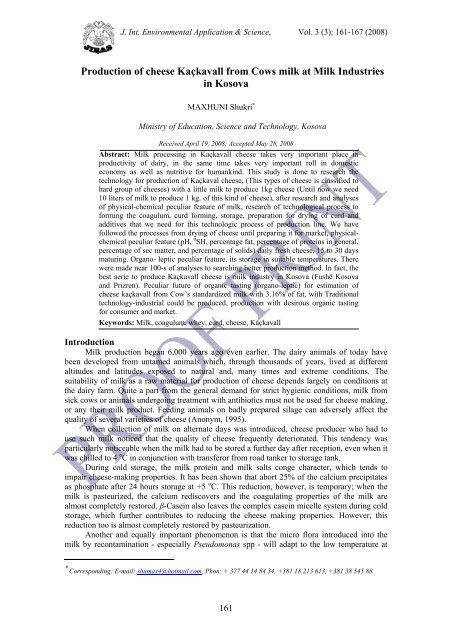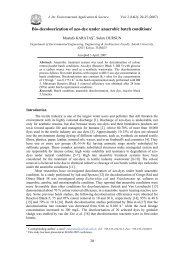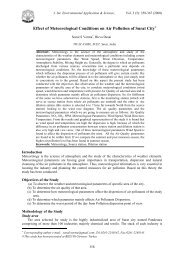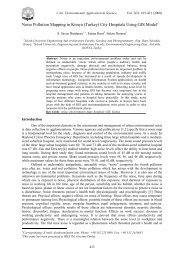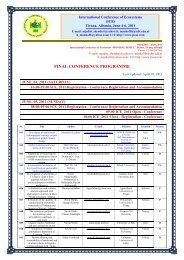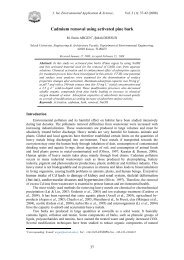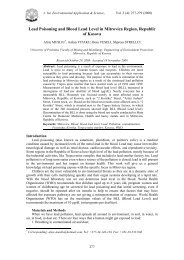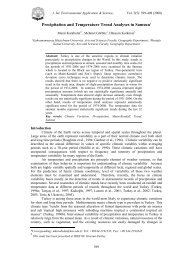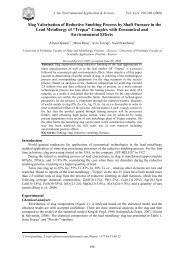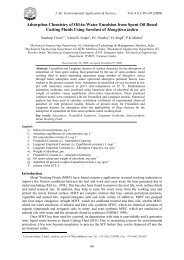Production of cheese Kaçkavall from Cows milk at Milk Industries in ...
Production of cheese Kaçkavall from Cows milk at Milk Industries in ...
Production of cheese Kaçkavall from Cows milk at Milk Industries in ...
- No tags were found...
Create successful ePaper yourself
Turn your PDF publications into a flip-book with our unique Google optimized e-Paper software.
J. Int. Environmental Applic<strong>at</strong>ion & Science, Vol. 3 (3): 161-167 (2008)which the enzymes, prote<strong>in</strong>s and lipases, will decompose prote<strong>in</strong> and f<strong>at</strong> respectively. The result<strong>of</strong> such action is a “bitter” flavour eman<strong>at</strong><strong>in</strong>g <strong>from</strong> decomposition <strong>of</strong> the β- case<strong>in</strong> th<strong>at</strong> has leftthe case<strong>in</strong> micelle dur<strong>in</strong>g low - temper<strong>at</strong>ure storage (Coralba, 1982; Anonym, 1995).Cheese has been made <strong>in</strong> most cultures <strong>from</strong> ancient times. Cheese is a <strong>milk</strong> concentr<strong>at</strong>e,the basic solids <strong>of</strong> which consist ma<strong>in</strong>ly <strong>of</strong> prote<strong>in</strong>, actually case<strong>in</strong> and f<strong>at</strong>. The residual liquid iscalled whey. As a rule <strong>of</strong> thumb, the case<strong>in</strong> and f<strong>at</strong> <strong>in</strong> the <strong>milk</strong> are concentr<strong>at</strong>ed approx. 10 times<strong>in</strong> production <strong>of</strong> hard and semi-hard types <strong>of</strong> <strong>cheese</strong>. No strict def<strong>in</strong>ition <strong>of</strong> the concept <strong>of</strong><strong>cheese</strong> is possible, as so many variants exist (Anonym, 1995). The hugest <strong>cheese</strong> ever made wasa Cheddar <strong>cheese</strong> weigh<strong>in</strong>g 15 190 kg. I was produced <strong>in</strong> January 1964 by the Wiscons<strong>in</strong>Found<strong>at</strong>ion to be exhibited <strong>at</strong> the World Expo <strong>in</strong> New York; it took 43 hours to produce. In1974, some Russians found a <strong>cheese</strong> <strong>in</strong> the permafrost <strong>of</strong> the Siberian tundra. It was <strong>at</strong> least2000 years old and was said to be an unrivalled delicacy (Anonym, 1995).The fact for this product is th<strong>at</strong> has found nice place <strong>in</strong> <strong>milk</strong> <strong>in</strong>dustries <strong>in</strong> Kosova (FushëKosova, Prizren). Peculiar future <strong>of</strong> organic tast<strong>in</strong>g (oregano-leptic) for estim<strong>at</strong>ion <strong>of</strong> <strong>cheese</strong><strong>Kaçkavall</strong> <strong>from</strong> cow’s standardized <strong>milk</strong> with 3.16% <strong>of</strong> f<strong>at</strong>, with traditional technology<strong>in</strong>dustrialcould be produced, production with desirous organic tast<strong>in</strong>g (organo-leptic) forconsumer and market.Methods and M<strong>at</strong>erialsIt is used fresh <strong>milk</strong> to produce <strong>cheese</strong> <strong>of</strong> Kaçkaval-unpasteurized cows with theseparameters. For physical-chemical peculiar fe<strong>at</strong>ure <strong>of</strong> <strong>milk</strong> and Kaçkaval samples were usedthese methods:-Soxhelt-Henkels method were used to def<strong>in</strong>e sour taste,-For def<strong>in</strong>ition <strong>of</strong> pH value were used a pH-metre (Miskra, Kran, Typ MA 5730),-For def<strong>in</strong>ition <strong>of</strong> <strong>milk</strong> density were used a Laktodezimetre,-For def<strong>in</strong>ition <strong>of</strong> f<strong>at</strong> percentage % were use the method <strong>of</strong> Gerber,-For def<strong>in</strong>ition <strong>of</strong> dry m<strong>at</strong>ters until dry<strong>in</strong>g up <strong>of</strong> constant mass,-Dry quantity <strong>of</strong> mass without f<strong>at</strong> has been done <strong>in</strong> calcul<strong>at</strong>ed way,-Percentage <strong>of</strong> f<strong>at</strong> <strong>at</strong> dry mass has been done <strong>in</strong> calcul<strong>at</strong>ed way,-W<strong>at</strong>er quantity has been done <strong>in</strong> calcul<strong>at</strong>ed way,-For def<strong>in</strong>ition <strong>of</strong> Nitrogen (N) were used the Kjeldahs method,-For def<strong>in</strong>ition <strong>of</strong> sal<strong>in</strong>e (NaCl) were done accord<strong>in</strong>g to the IDF standards,Beside, equipments and devices which are provided with regul<strong>at</strong>ions to def<strong>in</strong>e the physicalchemicalpeculiar fe<strong>at</strong>ure <strong>of</strong> <strong>milk</strong> and <strong>cheese</strong> were used as well the below mentioned:-Technological l<strong>in</strong>e for production <strong>of</strong> Kaçkaval <strong>cheese</strong>, consist <strong>from</strong>: tw<strong>of</strong>old b<strong>at</strong>h withcapacity <strong>of</strong> 5,000 L (Nederlands b<strong>at</strong>h equipped with equipment for benefit<strong>in</strong>g <strong>of</strong> coagulantdoughmass-curd),-Coagulant bak<strong>in</strong>g l<strong>in</strong>e-“Maxhar’’ Budapest, Hungarian,-Frames,-Shelfs (Pejiq, 1972; Coralba, 1982).<strong>Production</strong> <strong>of</strong> <strong>cheese</strong> goes through different phases th<strong>at</strong> are common to allot <strong>of</strong> <strong>cheese</strong>sorts. There are also other ways <strong>of</strong> tre<strong>at</strong>ment, which are specific to certa<strong>in</strong> varieties. Cheese <strong>milk</strong>is pre-tre<strong>at</strong>ed, possibly premiered after addition <strong>of</strong> a bacterial culture appropri<strong>at</strong>e to the type <strong>of</strong><strong>cheese</strong>, and mixed with rennet. The enzyme activity <strong>of</strong> the rennet causes the <strong>milk</strong> to coagulum.This mass is cut with special cutt<strong>in</strong>g tools <strong>in</strong>to small cubes (1x1 cm) <strong>of</strong> the desired size -aboveall to enable share- out the whey. Dur<strong>in</strong>g the rest <strong>of</strong> the curd mak<strong>in</strong>g process the bacteria growand form lactic acid, and the curd gra<strong>in</strong>s are subjected to mechanical tre<strong>at</strong>ment with stirr<strong>in</strong>gtools, while <strong>at</strong> the same time the curd is he<strong>at</strong> up accord<strong>in</strong>g to prearranged programmed. Thecomb<strong>in</strong>ed effect <strong>of</strong> these there actions -growth <strong>of</strong> bacteria, mechanical tre<strong>at</strong>ment and he<strong>at</strong>tre<strong>at</strong>ment- results <strong>in</strong> sunrises, i.e. separ<strong>at</strong>ion <strong>of</strong> whey <strong>from</strong> the curd. The f<strong>in</strong>ished curd is placed<strong>in</strong> <strong>cheese</strong> moulds <strong>of</strong> metal, wood or plastics, which determ<strong>in</strong>es the shape <strong>of</strong> the f<strong>in</strong>ished <strong>cheese</strong>.The <strong>cheese</strong> is pressed, either by its own weight or more commonly by apply<strong>in</strong>g pressure to the162
J. Int. Environmental Applic<strong>at</strong>ion & Science, Vol. 3 (3): 161-167 (2008)Figure1. Process<strong>in</strong>g diagram <strong>of</strong> <strong>Kaçkavall</strong> <strong>cheese</strong>Cow’s fresh raw <strong>milk</strong> not-pasteurized (5000 l, with 3.16% <strong>of</strong> f<strong>at</strong>) (Jacketed <strong>cheese</strong> v<strong>at</strong> with bean anddrive motor for tools, capacities 5000 l)Sampl<strong>in</strong>g for <strong>milk</strong> analysisCool<strong>in</strong>g <strong>of</strong> <strong>milk</strong> t 33 o C (V<strong>at</strong> dur<strong>in</strong>g stirr<strong>in</strong>g)Dur<strong>in</strong>g <strong>in</strong>cub<strong>at</strong>ion (40 m<strong>in</strong>utes)(<strong>Milk</strong>) culture castaway (100gr remover <strong>in</strong> 3 l <strong>of</strong> w<strong>at</strong>er)Process<strong>in</strong>g <strong>of</strong> Coagul<strong>at</strong>ion (cutt<strong>in</strong>g gently breaks the curd up <strong>in</strong>to gra<strong>in</strong>s <strong>in</strong>to Gra<strong>in</strong>s with a size 1x1 cm)Curd manufactureSampl<strong>in</strong>g - Extraction -expulsion <strong>of</strong> whey – sunrises(V<strong>at</strong> dur<strong>in</strong>g whey dra<strong>in</strong>age)Add warm w<strong>at</strong>er <strong>in</strong> jacketed <strong>cheese</strong>Recoil<strong>in</strong>g <strong>of</strong> Coagulum exud<strong>at</strong>ion (dry<strong>in</strong>g <strong>of</strong> coagulum <strong>in</strong> 42 o C)Sampl<strong>in</strong>g - Extraction -expulsion <strong>of</strong> whey - Leaven castaway(V<strong>at</strong> dur<strong>in</strong>g whey dra<strong>in</strong>age)Curd mak<strong>in</strong>gCutt<strong>in</strong>g curd (<strong>in</strong> size 17x30 cm)Dry<strong>in</strong>g <strong>of</strong> curd (<strong>in</strong> t o 24 o C about 16 hours)Cheese bak<strong>in</strong>g -Bak<strong>in</strong>g curd <strong>in</strong> Delic<strong>at</strong>essen (Salamura) with 15% NaCl,In t o 75 o C, long 2 - 3 m<strong>in</strong>utesMold<strong>in</strong>ess <strong>of</strong> <strong>cheese</strong>Cheese packag<strong>in</strong>g (with mould <strong>in</strong> t o 25 o C, between 24 hours)Dry<strong>in</strong>g <strong>of</strong> <strong>cheese</strong> one day <strong>in</strong> t o 20 o CSalt<strong>in</strong>g <strong>of</strong> <strong>cheese</strong> <strong>in</strong> t o 20 o C between two weeksDry<strong>in</strong>g <strong>of</strong> <strong>cheese</strong> <strong>in</strong> t o 20 o o C, with 85% <strong>of</strong> humidity, between one monthCheese preserv<strong>at</strong>ionTabe 3. The results <strong>of</strong> physical – chemical peculiarity <strong>of</strong> Kaçkaval <strong>cheese</strong> produced by cow’s<strong>milk</strong> dur<strong>in</strong>g thirty days (15) bak<strong>in</strong>g164
J. Int. Environmental Applic<strong>at</strong>ion & Science, Vol. 3 (3): 161-167 (2008)Luqet FM, 1990, Laits et produits laitiers, Vache, Brebis, Chevre 2. Les produit laitiers,Transform<strong>at</strong>ion et technologies, Technique et Document<strong>at</strong>ion-Lavoisier, 11, rueLavoisier- 75384 Paris Cedex 08Pejiq O, Djordjeviq, J.,1972, “Mlekarski praktikum”, Zavod za udjbenike i nastavne sredstvaSerrbije, Beograd.Petriciq A, 1984, Konzumno i fermentirano mlijeko, Zagreb, Tisak: SOUR “Vjesnik” OOURTiM, Zagreb.167


